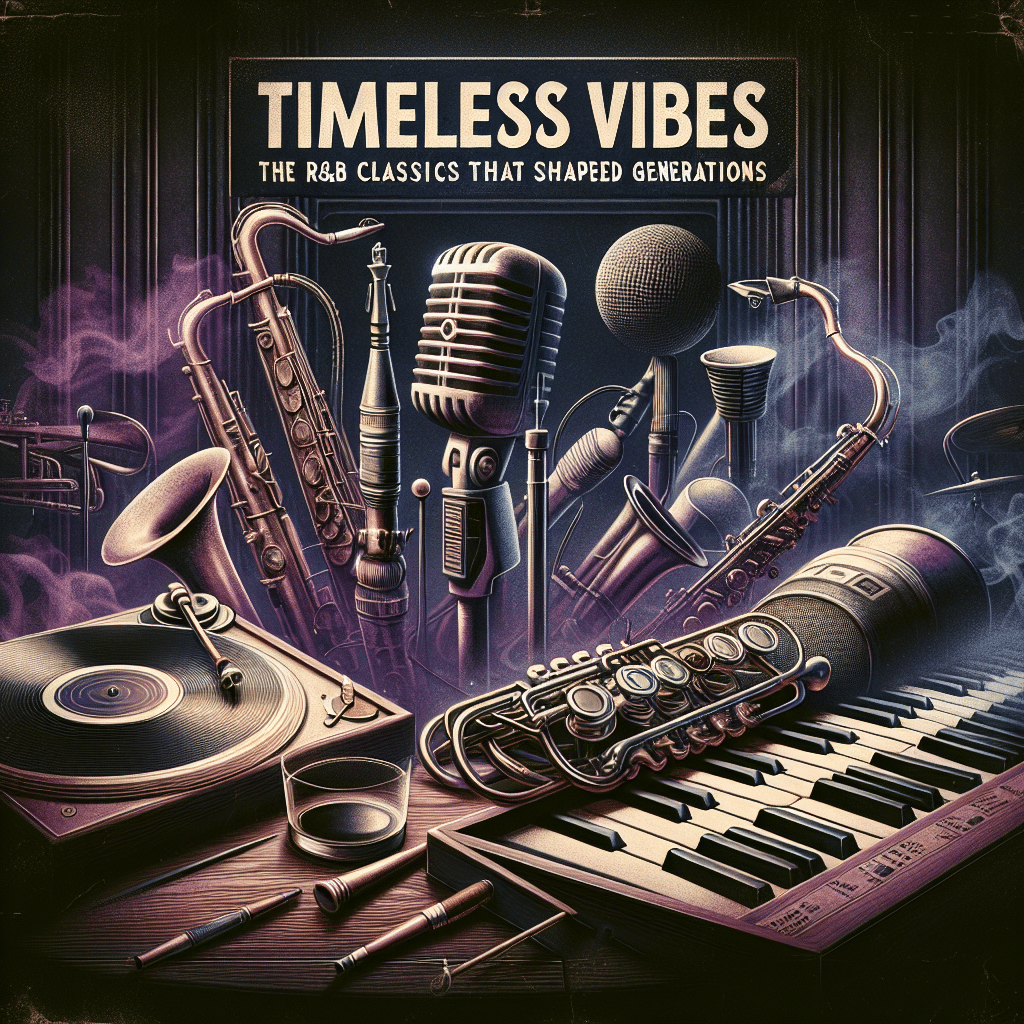Timeless Vibes: The R&B Classics That Shaped Generations

Rhythm and Blues (R&B) is more than just a genre; it is a cultural movement, a fusion of soul, jazz, and funk that has profoundly shaped the musical landscape. R&B classics have transcended time, conveying emotions, telling stories, and offering genres a foundation on which new artists and trends could flourish. This article will explore the most influential R&B classics that have shaped generations, their historical context, and their enduring importance in today’s music landscape.
The Origins of Rhythm and Blues
R&B originated in the African American communities in the 1940s and 1950s, originally named “race music.” It emerged from the fusion of gospel, jazz, and blues, uniquely reflecting the struggles, joys, and aspirations of African Americans. The term “Rhythm and Blues” was coined in 1949 by Jerry Wexler at Atlantic Records as a more marketable label. Artists like Ray Charles and Ruth Brown began to put out music under the R&B banner, making the term synonymous with heartfelt ballads and upbeat dance tracks.
Key Artists and Their Contributions
1. Ray Charles
See Also: Soulful Sounds: The Top R&B Artists Redefining the Genre Today
Soulful Sounds: The Top R&B Artists Redefining the Genre TodayRay Charles is an iconic figure in R&B and is credited with modernizing the genre. His hit “I Got a Woman” (1954) blended gospel and blues, paving the way for future soul music. The emotional depth and vocal prowess Ray embodied set a standard for all R&B singers who followed.
2. Aretha Franklin
Often hailed as the “Queen of Soul,” Aretha Franklin brought unprecedented strength and emotion to R&B music. Her rendition of “Respect” (1967) became an anthem for the civil rights movement while also establishing her as a symbol of female empowerment. The song remains timeless, resonating with new generations seeking social justice.
3. Otis Redding
Otis Redding’s passionate delivery in tracks like “Sittin' on the Dock of the Bay” (1968) showcased the power of vulnerability in R&B music. His unique voice and heartfelt lyrics encapsulated the pain and beauty of love and loss. Even after his untimely death in a plane crash, Redding’s influence endures through contemporary artists who admire his craft.
See Also: R&B Royalty: Celebrating This Year’s Chart-Toppers and Their Impact on the Genre
R&B Royalty: Celebrating This Year’s Chart-Toppers and Their Impact on the GenreThe Golden Age of R&B (1960s-1970s)
During the 1960s and 70s, R&B evolved, integrating funk and soul, leading to an explosion of hits that continue to define the genre. This era gave birth to legendary groups and artists who left an indelible mark.
4. Marvin Gaye
Marvin Gaye’s groundbreaking album “What’s Going On” (1971) addressed social issues like poverty, environmental degradation, and war. The title track’s blend of smooth melodies and poignant lyrics opened up new discussions in music about societal challenges, making him an emblematic figure for R&B's socially conscious movement.
5. The Supremes
As one of Motown’s flagship acts, The Supremes redefined what a girl group could achieve. With hits like “You Can’t Hurry Love” (1966), they not only set commercial records but also paved the way for future female artists in various genres. Their music exudes timeless vibes that continue to influence pop culture today.
See Also: Soulful Sounds: How R&B Classics Shaped the Music Landscape
Soulful Sounds: How R&B Classics Shaped the Music LandscapeThe Evolution of R&B
As R&B progressed into the 1980s and 1990s, it picked up elements from hip-hop, pop, and electronic music. New artists emerged, and the genre began to branch out in various directions.
6. Whitney Houston
Whitney Houston captivated audiences with her exceptional vocal talent and remarkable range. Her rendition of “I Will Always Love You” (1992) from "The Bodyguard" soundtrack remains one of the best-selling singles of all time. Houston infused R&B with elements of pop and soul, elevating the genre to new heights and inspiring a new generation of artists.
7. Boyz II Men
See Also: Melodies of a Generation: Top 10 R&B Classics You Still Can't Resist
Melodies of a Generation: Top 10 R&B Classics You Still Can't ResistThis group epitomized the smooth, harmonious sound of R&B in the 1990s. Their classic “End of the Road” (1992) showcased their unparalleled vocal ability and lyrical depth, standing as one of the longest-reigning number one hits in Billboard history. Their influence has been lasting, inspiring acts from Justin Timberlake to contemporary groups.
Contemporary R&B: A New Wave
As we transitioned into the 2000s, R&B began to merge significantly with hip-hop and electronic music. Artists like Beyoncé, Usher, and Alicia Keys began to introduce more diverse influences, blending genres to reach wider audiences. Their songs maintain the classic emotional depth of R&B while reflecting modern sentiments and experiences.
Conclusion: The Timeless Impact of R&B Classics
Timeless R&B classics have shaped generations of music lovers, providing an emotional connection that resonates across cultures and ages. The genre has continually adapted, making room for new voices while preserving the foundational elements that make it unique. Understanding and appreciating these classics is vital for recognizing the evolution of music and how it reflects societal changes over time. Each of these vestiges plays a critical role in shaping the sonic landscape of every generation, merging memories, emotions, and experiences.
See Also: From Motown to Modern: The Evolution of R&B Classics Through the Decades
From Motown to Modern: The Evolution of R&B Classics Through the DecadesFAQs about Timeless R&B Classics
1. What defines R&B music?
R&B music is characterized by its soulful vocal delivery, emotional themes, and a blend of rhythm and blues influences. It encompasses a wide range of sub-genres and styles, including soul, funk, and contemporary hip-hop influences.
2. Who are some modern R&B artists continuing the legacy?
Contemporary artists like H.E.R., Daniel Caesar, SZA, and Khalid embody the spirit of R&B while infusing their personal experiences and modern sounds, keeping the genre alive and relevant.
3. Why are R&B classics still important today?
See Also: Heartfelt Harmonies: The Emotional Power of R&B Love Ballads
Heartfelt Harmonies: The Emotional Power of R&B Love BalladsR&B classics serve as a cultural touchstone, connecting listeners to the historical struggles and triumphs of their predecessors. The emotional depth in R&B music transcends time, allowing it to resonate with new generations.
4. How did R&B impact other genres of music?
R&B has profoundly influenced genres such as hip-hop, pop, and rock. Elements of R&B - including its rhythms, melodies, and vocal techniques - are evident across a variety of musical styles today.
5. What is the role of R&B in social movements?
R&B music has historically been a voice for change and empowerment, providing anthems for civil rights, gender equality, and more. Artists use the platform to address sociopolitical issues and inspire action.
See Also: Diversity in Pop: Celebrating the Best Female and Male Artists of the Genre
Diversity in Pop: Celebrating the Best Female and Male Artists of the GenreAs we celebrate the legacy of Timeless Vibes: The R&B Classics That Shaped Generations, it is essential to recognize how this genre continues to inspire and connect. Each note and lyric carries the weight of history and the promise of future generations to come.
If you want to know other articles similar to Timeless Vibes: The R&B Classics That Shaped Generations you can visit the category R&B.
